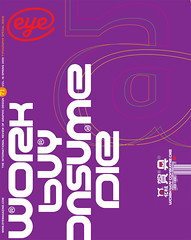Spring 2009
Pattern recognition
Geometric: Graphic Art and Pattern Fonts
By (Nicole and Petra) Kapitza<br>Verlag Hermann Schmidt, €68<br>Unless you have had your head stuck in a white cube since the flip of the millennium you’ll have noticed the proliferation of pattern across all design media. For some it is the final nail in Modernism’s coffin; for others, ‘more is more’ (see ‘The decriminalisation of ornament’, Eye no. 58).
Pattern is everywhere, from the screen of a mobile phone to the sole of a running shoe, on clothing, homewares, magazine covers . . . and not just flat pattern but structural too, in lighting, jewellery, furniture and buildings. What Buckminster Fuller started in the 1940s with his geodesic dome, ‘the ground-breaking use of so-called tensegrity structures – loadbearing structures, which, by balancing compression and tension are self-stabilising’ (Patterns 2), Rem Koolhaas has developed to cathedral-sized proportions, in the gravity-defying, light-infused Central Library in Seattle.
In Adolf Loos’s controversial essay, ‘Ornament and Crime’ (1908), decoration was designated a sign of regressive behaviour, and best left to the ‘uncivilised’ tribes. While his attitude now seems racist and bizarre, the essay is still mentioned in art school contextual studies, its influence to be noted lest we forget it helped usher in a century of plain-speaking hegemony: ‘good taste’ as suffocating blankness. The editors of Patterns 2: Design, Art and Architecture acknowledge that once-prevailing attitude in Petra Schmidt’s introduction: ‘It was an open secret for years; anybody wanting to score a distinction at one of the many German design competitions should submit their product in black, white, or, even better, silver.’
What you will find here is the antidote to such thinking, with examples from fashion, graphics, photography, architecture and product design assembled into an impressive compendium demonstrating that pattern is about more than decoration – it is, in the hands of some practitioners, invention made manifest.
Entries are divided into two categories: pattern as order, as in non-ancillary structure (often derived from nature); and as disorder, revelling in a riot of eclecticism, layered, juxtaposed and celebrated; both Euclidian and non-Euclidian forms abound. The editors also attempt to redress the ‘disappearing’ of pattern and the fact that it was written out of the history of design, by including examples from the heyday of Modernism – fabrics by Anni Albers (director of the weaving workshop at the Bauhaus), and patterns on paper by Josef Hoffman (co-founder of the Wiener Werkstätte).
The emphasis is on work by contemporary practitioners, though, with large-scale photos of projects; informative captions, at the back of the book, provide a useful stepping-stone to further research. Where, though, is Koolhaas’s library, as mentioned in the introduction? For all its perfect production values, and cross-disciplinary selection, Patterns 2 may suffer from the practical constraints common to all compendiums: did some potential contributors refuse to play ball?
If you feel pattern-inspired after all that, then pick up Geometric by the sibling team of Nicole and Petra Kapitza (see Eye no. 58 vol. 14). They love pattern, and have created 100 pattern-making fonts that can be manipulated using typographic instructions, such as leading, spacing, type size and colour. Packaged with a doorstep-thick book of both monochrome and psychedelic examples showing some incredible results, the disc of fonts comes with an easy tutorial to get you started. All in all, an indispensable tool for any designer. Bring it on!
First published in Eye no. 71 vol. 18 2009
Eye is the world’s most beautiful and collectable graphic design journal, published quarterly for professional designers, students and anyone interested in critical, informed writing about graphic design and visual culture. It is available from all good design bookshops and online at the Eye shop, where you can buy subscriptions and single issues.

